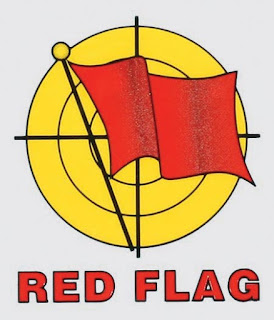RED FLAG, a realistic combat training exercise involving the air forces of the United States and its allies, is coordinated at Nellis Air Force Base, Nev., and conducted on the vast bombing and gunnery ranges of the Nevada Test and Training Range. It is one of a series of advanced training programs administered by the United States Air Force Warfare Center and Nellis and executed through the 414th Combat Training Squadron. RED FLAG was established in 1975 as one of the initiatives directed by General Robert J. Dixon, then commander of Tactical Air Command, to better prepare our forces for combat. Tasked to plan and control this training, the 414th Combat Training Squadron's mission is to maximize the combat readiness, capability and survivability of participating units by providing realistic training in a combined air, ground, space and electronic threat environment while providing for a free exchange of ideas between forces.
Aircraft and personnel deploy to Nellis for RED FLAG under the Air Expeditionary Force concept and make up the exercise's "Blue" forces. By working together, these Blue forces are able to utilize the diverse capabilities of their aircraft to execute specific missions, such as air interdiction, combat search and rescue, close air support, dynamic targeting and defensive counter air. These forces use various tactics to attack NTTR targets such as mock airfields, vehicle convoys, tanks, parked aircraft, bunkered defensive positions and missile sites. These targets are defended by a variety of simulated "Red" force ground and air threats to give participant aircrews the most realistic combat training possible.
The Red force threats are aligned under the 57th Adversary Tactics Group, which controls seven squadrons of USAF Aggressors, including fighter, space, information operations and air defense units. The Aggressors are specially trained to replicate the tactics and techniques of potential adversaries and provide a scalable threat presentation to Blue forces which aids in achieving the desired learning outcomes for each mission.
A typical RED FLAG exercise involves a variety of attack, fighter and bomber aircraft (F-15E, F-16, F/A-18, A-10, B-1, B-2, etc.), reconnaissance aircraft (Predator, Global Hawk, RC-135, U-2), electronic warfare aircraft (EC-130s, EA-6Bs and F-16CJs), air superiority aircraft (F-22, F-15C, etc), airlift support (C-130, C-17), search and rescue aircraft (HH-60, HC-130, CH-47), aerial refueling aircraft (KC-130, KC-135, KC-10, etc), Command and Control aircraft (E-3, E-8C, E-2C, etc) as well as ground based Command and Control, Space, and Cyber Forces.
A "White" force in RED FLAG uses the Nellis Air Combat Training System (NACTS) monitor this mock combat between Red and Blue. NACTS is the world's most sophisticated tracking system for combat training exercises and allows commanders, safety observers and exercise directors to monitor the mission and keep score of simulated 'kills' while viewing the simulated air battle as it occurs.
As RED FLAG expanded to include all spectrums of warfare (command, control, intelligence, electronic warfare) and added night missions to each exercise period, the combination of NACTS, improved tactics, and increased aircraft/aircrew capabilities improved flying safety.
All four U.S. military services, their Guard/Reserve components and the air forces of other countries participate in each RED FLAG exercise. Since 1975, 28 countries have joined the U.S. in these exercises. Several other countries have participated as observers. RED FLAG has provided training for more than 440,000 military personnel, including more than 145,000 aircrew members flying more than 385,000 sorties and logging more than 660,000 hours of flying time.
This mock battle in the skies over the Nevada Test and Training Range has yielded results that will increase the combat capability of our armed forces for any future combat situation.
ARTICULOS
- Hispaviacion
- Leading Edge
- UK Airshow Review: Part 1 / Part 2
VÍDEOS

